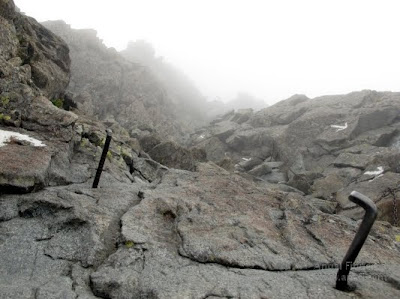In the Shadow of the Spear
It is twenty-two kilometres from Kamikochi to the summit of Yari-ga-take. That sounds daunting but more than half the route is along an easy, well-trodden path following the Azusa River upstream. It is not until three or four hours into the hike, when approaching the Karasawa mountain hut--the fourth from Kamikochi, that the path gets steep and rugged.
By this point I have barely gained two hundred metres in elevation, and there is another 1475 metres to ascend. The hordes of squealing day trippers are no longer tagging me--you can be sure that from Karasawa hut all those left on the trail and heading north share the same goal: The Spear, a fitting moniker in Japanese for one of the most exciting climbs in the Kita Alps. At 3,180 metres it is the fifth tallest mountain in the country and an engaging setting for a test of the soul.
The approach from Karasawa hut is first through a light forest and then over exposed boulders buttressing Nishi-dake, Mt Yari's neighbour to the east. At a clearing I rejoin the Azusa and follow the valley floor. Looming on both sides are mountain ridges crowned with wispy, flirtatious clouds. Here and there I spot a distant waterfall halfway up a mountain, and along the path are flowers in purple, yellow and white. There is one flower that keeps catching my eye. It has purple petals and a shape which brings to mind the phrygian caps of the French Revolution.
Shortly before a junction where a path on the left leads to Minami-dake, the gentle, meandering trail merges into a ramp of white rocks. This is the start of a slow, seemingly endless slog where 1000 metres of elevation gain is rammed into the final two and a half kilometres. The Spear is but a mind game from here on. Congratulating oneself for making it this far is somewhat hollow; while you may feel chuffed for being physically able to have hiked close to twenty kilometres, the final, vertical push for that distant pyramid of silver boulders--supporting a 20 kg backpack along exposed rock, year-round snowfields and dizzying heights--is all mental.
Well above the tree line I am grateful for the occasional blast of wind to cool my sweat-drenched shirt. With a slow, steady ascent comes a growing awareness of marvelous views all around, as well as that dawning elation of being in a stunning alpine setting. Soon I am level with the ridges of nearby mountains and the sights of even more mountains and valleys beyond make me gasp. Curving north with half a kilometre to go, the route leads into a devil's garden of sharp boulders lying at the base of the last ridge 300 metres above, where lies The Spear, seemingly out of place with its surreal, triangular shape planted as if on a whim by a giant with a queer sense of humour.
My legs are screaming when I reach the second mountain hut below the summit. With its name derived from a compound of the Chinese characters for life and death, I think it is aptly named: I barely feel alive, and when I follow the hut manager's directions to look for the campsite which is supposed to be nearby--only to be greeted by more boulders as I climb into a small plateau--I reckon I will collapse from bewilderment, for there is no place to pitch a tent, it seems. No one else has camped here; all I see is jagged rock. I stand there alone at 3000 metres altitude, exhausted and nearly delirious, under the pounding rays of the sun and with The Spear still looming above me, to make what I can of this sea of boulders. I had noticed a dozen or so hikers along the route ahead of me--while some would pass this hut and spend the night at the hut above (on the ridge below the summit) surely I wasn't the only sorry soul who had lugged a tent this far. Where were the others? Then I spot the small, level spaces in between the boulders, just big enough for a one man tent. Ah. So I would be the only one here, after all. The other hikers must have pitched further up or are staying overnight in the huts.
By mid afternoon my tent is up and, after a quick snack, I begin the final climb to the summit. What a difference a short rest and some food make--I am still full of energy as I make it to the ridge, pass the last hut and head to the The Spear for the final hundred metres or so. Here is where it gets fun. Iron spikes, chains and ladders bolted into vertical rock guide you to the very top, which is a jagged area measuring about fifteen square metres. Acting as a summit marker is a small wooden shrine, and before you, all around, is the wondrous expanse of the Kita Alps--that is, when the clouds decide not to dart in.
Back at my tent, while the sun descends, I spot masses of long clouds below me, gliding like giant airships through the surrounding valleys. A magical twilight of tinted clouds dancing along the ridge fades into a starry night where I watch constellations, satellites and a shooting star. A chilly but slumbrous night follows. Sunrise is spent on the ridge between the peaks of Mt Yari and Mt Nishi. As the flared sun breaks above the peaks past Mt. Jonen, a distant Mount Fuji glows in an orange midst.
A golden glow envelopes the mountain. By now I feel in a state of grace, as The Spear assumes a mystic essence above me, and I sense in its shadow that for the last twenty four hours I was under a spiritual test. Refreshed, focused, enchanted, humbled and in a clear state of mind, I descend.




































No comments:
Post a Comment